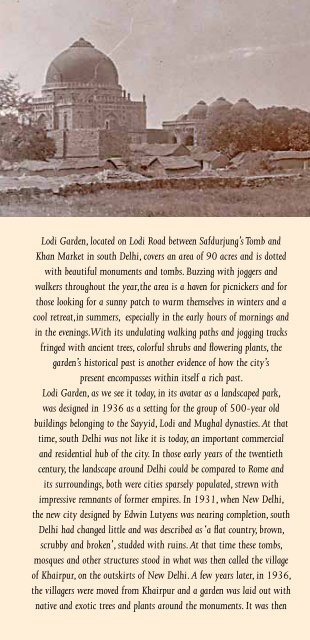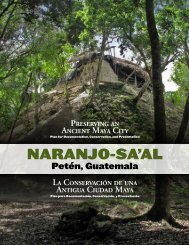Lodi Garden and the Golf Club (pdf) - World Monuments Fund
Lodi Garden and the Golf Club (pdf) - World Monuments Fund
Lodi Garden and the Golf Club (pdf) - World Monuments Fund
Create successful ePaper yourself
Turn your PDF publications into a flip-book with our unique Google optimized e-Paper software.
<strong>Lodi</strong> <strong>Garden</strong>, located on <strong>Lodi</strong> Road between Safdurjung’s Tomb <strong>and</strong><br />
Khan Market in south Delhi, covers an area of 90 acres <strong>and</strong> is dotted<br />
with beautiful monuments <strong>and</strong> tombs. Buzzing with joggers <strong>and</strong><br />
walkers throughout <strong>the</strong> year,<strong>the</strong> area is a haven for picnickers <strong>and</strong> for<br />
those looking for a sunny patch to warm <strong>the</strong>mselves in winters <strong>and</strong> a<br />
cool retreat,in summers, especially in <strong>the</strong> early hours of mornings <strong>and</strong><br />
in <strong>the</strong> evenings. With its undulating walking paths <strong>and</strong> jogging tracks<br />
fringed with ancient trees, colorful shrubs <strong>and</strong> flowering plants, <strong>the</strong><br />
garden’s historical past is ano<strong>the</strong>r evidence of how <strong>the</strong> city’s<br />
present encompasses within itself a rich past.<br />
<strong>Lodi</strong> <strong>Garden</strong>, as we see it today, in its avatar as a l<strong>and</strong>scaped park,<br />
was designed in 1936 as a setting for <strong>the</strong> group of 500-year old<br />
buildings belonging to <strong>the</strong> Sayyid, <strong>Lodi</strong> <strong>and</strong> Mughal dynasties. At that<br />
time, south Delhi was not like it is today, an important commercial<br />
<strong>and</strong> residential hub of <strong>the</strong> city. In those early years of <strong>the</strong> twentieth<br />
century, <strong>the</strong> l<strong>and</strong>scape around Delhi could be compared to Rome <strong>and</strong><br />
its surroundings, both were cities sparsely populated, strewn with<br />
impressive remnants of former empires. In 1931, when New Delhi,<br />
<strong>the</strong> new city designed by Edwin Lutyens was nearing completion, south<br />
Delhi had changed little <strong>and</strong> was described as ‘a flat country, brown,<br />
scrubby <strong>and</strong> broken’, studded with ruins. At that time <strong>the</strong>se tombs,<br />
mosques <strong>and</strong> o<strong>the</strong>r structures stood in what was <strong>the</strong>n called <strong>the</strong> village<br />
of Khairpur, on <strong>the</strong> outskirts of New Delhi. A few years later, in 1936,<br />
<strong>the</strong> villagers were moved from Khairpur <strong>and</strong> a garden was laid out with<br />
native <strong>and</strong> exotic trees <strong>and</strong> plants around <strong>the</strong> monuments. It was <strong>the</strong>n

















